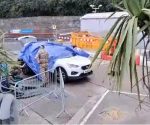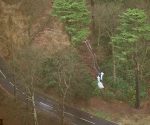Julia Ghost: A defence for Callum Wheeler, no bar qualification required (Part One)
It’s been said before in these pages that glorified shysters who allow themselves to be flattered with titles of “Justice” or “Queen’s Counsel” (because there is no honour, righteousness or merit to be had in being a dog to persecute a deranged animal in the equivalent of a baiting pit) had better pray that there isn’t a restoration of law and order in the UK.
On 8th July of this year, when Callum Wheeler appeared at Canterbury Crown Court to be sentenced to life imprisonment with a minimum term of 37 years, for the murder of Julia James, he had to be carried in by staff from Broadmoor – that’s the hospital for the “criminally” lunatic. When he has was asked to confirm his identity, he would not do it, and his defence barrister did it in his stead. When he was asked to stand to hear the verdict, he would not, and was instead held up by his hospital minders.
Despite his clearly not having all his marbles so that preparation to commit an offence might not have been possible, and despite pitifully poor evidence that he had committed a sexual crime, Wheeler was savaged by the presiding bandog (one called Wall), naturally taking his lead from the prosecuting cur (Morgan), in the following way:
I am drawn on the evidence to the obvious conclusion that this was a not a spur of the moment aberration by you. Rather it was an attack which was planned and thought through in advance… You were there looking for a lone female victim and you were sexually motivated to do so.”
The evidence mentioned in the extract was sold to the jury (potentially primed to be optimally receptive to it, comprised as it was of twice as many woman as men) as being “a large body” complete in its capacity to incriminate Wheeler. “The prosecution” said the lead of that pack, “will invite you to conclude that the evidence shows beyond any doubt that he obviously had… [the] intention [to cause serious harm]”. It ran as follows:
Sightings of a man fitting Wheeler’s description, prior to the murder, in the countryside of the “local area”, and in the vicinity of where the attack took place, were used to imply that Wheeler was scoping out where he could best ambush a victim. Because the prosecution had no doubt that, with Wheeler being “a highly sexualised individual” (having looked at pornography), and his having performed an “internet search for the word rape, of course, two days before the attack”, attacking and molesting a woman “was plainly on his mind”. This condition was also evidence after his arrest when he declared to police that
Were [he] to be released he would go back to the area and have sex with women without their consent… he would knock them on the ground, rape them and kill them afterwards.
Perhaps most incriminating was the discovery of a “jack” in Wheeler’s possession. This metal bar for use in railway maintenance was said to have had Julia James’ blood on it, as well as Wheeler’s DNA. Moreover, traces of a material from the jack were also found in James’ hair. This, then, along with the apparent fact of James’ blood discovered on one of his shoes, represented Wheeler being caught in possession of the murder weapon, and as red-handed as he could possibly have been.
It did not end there. CCTV had captured a figure, alleged to be Wheeler, on his outward journey from the vicinity of his home, with the same camera spotting a figure returning later – this defined the parameters of his being out and about in the countryside, with the time of the murder falling between them. Another piece of footage more distinctly showed a man, said to be Wheeler, walking past the Aylesham Social Club at 1.08pm carrying a holdall with an object wrapped in a white plastic bag protruding from it – no less a thing than the murder weapon itself. With the prosecution insisting that “police officers… walked the route from this location to where Julia James was attacked. It takes about half an hour to 40 minutes”, this showed a tooled-up Wheeler was able to be at the scene of the crime, Ackholt Wood, so as to wait in ambush for Julia James. Additionally, dog walkers saw a man walking along a footpath near these woods between 1.30pm and 1.55pm
Other witnesses saw Callum Wheeler out in the countryside in the days between the incident and his arrest. Famously, on the very next day, he was spotted and spoken to by a gamekeeper, and the exchange was captured on dashcam video, where he was seen to be carrying a similar arrangement of holdall with white protuberance as was observed in the Aylesham Social Club footage. This was Wheeler “goading the police” or “looking for somewhere to dispose of the weapon”. Of his general conduct at this time, the prosecution said this:
The defendant continued to tour around the local area, sometimes carrying his bag and sometimes carrying what the prosecution alleges to be the murder weapon. He kept a check on the police cordon.
Here was Wheeler, then, at the same time as he was mocking it, keeping a concerned eye on an investigation which he knew would vector towards him – at least, this is the implication.
Completing the picture was a character testimony – of sorts. Ten days before the murder, two female PCSOs attended Wheeler’s address after he had made an aborted 999 call (no explanation given or required, apparently). Footage recorded by a body-worn camera showed someone (who one of the PCSOs would call “Callum”) speaking from a darkened front doorway to say “I’m not talking to you. Go on – get lost, man”. The two women went away when a man said to be Wheeler’s father spoke to them; from what he said, his son didn’t know himself why he had made the call. The incident was reported at Wheeler’s trial, where it was said to show him not wanting to have “any meaningful conversation with the police”, and that this was odd behaviour. The implication was quite clear: he was uncooperative, even hostile, and this was deviant (because, as the maxim of the age goes, one has nothing to fear if one has nothing to hide).
Upon his being arrested, Wheeler stated to police that he hadn’t killed Julia James, and then refused to answer questions. He did not, we are told, offer any assistance to the investigation. So, for instance, the police did not discover where he obtained the specialised piece of equipment that they alleged he used for a murder weapon. In another example, he offered no explanation for his comings and goings as documented by the prosecution, nor did he offer any information that could help explain why police found the forensic evidence they did.
However, come the start of the trial, there was a dramatic twist in the tale. Wheeler, although pleading not guilty, also admitted being responsible for Julia James’ death. This absurdly self-defeating concession would surely have been conceived by and offered to the court by Wheeler’s eminent and highly educated defence (having its own Queen’s Counsel in it), and it only remains for anyone to guess how little its emergence had anything to do with Wheeler’s own decision making. It was, in fact, an inexplicable failure of duty, and arguably made for a mistrial. Indeed, the conduct was indicative of the lawyers for the defence being compliant with an intent to convict come what may; in short, to let the court hand down a guilty verdict unopposed. Wheeler’s was a show trial.
And this is not rhetoric. It might be if it was the case that Wheeler’s was a lost cause, but it was far from being such a thing. It was quite feasible for Wheeler’s legal representative to have introduced enough doubt so that he could not be convicted safely. Reasonable doubt; a sufficient definition is this: where the assembled facts for the purpose of prosecution do not amount to absolute certainty, and other facts suggest innocence. Reader, if it seems that the principle of reasonable doubt, whereby there can be no conviction on a serious allegation unless there is good deal of certainty, is another common law feature that has been discarded these days by Her Majesty’s Courts, then it’s not surprising given that the justice system has adjusted for the purpose of upholding a “them and us” politicisation of society whereby particular criminals branded “terrorists” must, as a matter of course, be found guilty. This corruption is apparently not new, having for a long time been useful in imposing political agenda on an unassuming public, and we might say that Callum Wheeler is one of the latest to fall foul of it. In fact, the reason why there is a big problem with Wheeler’s case is precisely because all of the certainty required to convict was created by an inappropriate and unnecessary admission of culpability. It is the damning evidence needed to claim a show trial.
In the second part of this article, it will be shown how the evidence that supposedly so assuredly had Wheeler bang to rights actually did no such thing, and therefore how horribly unsuitable was the surrendering confession, and therefore how obvious it was as show trial component.


















